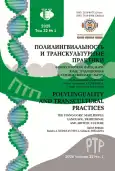Linguistic Features of the Ergonomic Space of the Central Streets of Yoshkar-Ola and Kazan
- Authors: Ivanova I.G.1, Khabibullina F.Y.1
-
Affiliations:
- Mari State University
- Issue: Vol 22, No 1 (2025): THE FINNO-UGRIC MARI PEOPLE: LANGUAGE, TRADITIONAL AND ARTISTIC CULTURE
- Pages: 49-66
- Section: Language in System
- URL: https://journal-vniispk.ru/2618-897X/article/view/326869
- DOI: https://doi.org/10.22363/2618-897X-2025-22-1-49-66
- EDN: https://elibrary.ru/GCPBSP
- ID: 326869
Cite item
Full Text
Abstract
The ergonomic space of cities, being an integral part of the onomastic space, has several features and is a means of expressing the linguistic personality of nominees. The article examines the ergonomic landscape of the central streets of the cities of Yoshkar-Ola, the capital of the Republic of Mari El, and Kazan, the capital of the Republic of Tatarstan, in a comparative aspect. The relevance of studying the ergonymicons of regional cities in modern Russia is important due to the special dynamism and social processes reflected in them. Urbanonyms as names of objects of various functional profiles are an indicator of preferred languages for naming urban objects, and act as a marker of the spheres of functioning of languages in a given territory. The purpose of the article is to identify the specifics of ergonyms of Yoshkar-Ola and Kazan at the lexico-semantic level in the direct motivation/indirect motivation dichotomy. The nomination process is determined by several factors, both linguistic and linguocultural in nature. Linguistic characteristics are manifested in the lexical and semantic features of the names of various types of enterprises, which indicate the properties of the object and contains a component indicating the sign of the name. Semantic groups are identified among ergonyms with direct motivation, which are characterized by distinctive features underlying the nomination: the profile of the enterprise, the geolocation of the object, an indication of the receiver (consumer), an indication of the sender (owner of the enterprise). Names with indirect motivation contain a component that signals the sign of the object of motivation, built on trails. Being a linguistic and cultural phenomenon, ergonyms act as cultural landmarks and social priorities of the modern society of the studied Russian regions. It is revealed that the process contributing to the change of the ergonymicon of the cities of Yoshkar-Ola and Kazan is the manifestation of national identity. The most frequent generating bases of ergonyms are considered, and their thematic classifications are presented. The material consisted of 486 names of public catering enterprises, shopping and industrial centers, cultural and entertainment facilities, beauty salons, service points, travel agencies, etc., selected by field research, observation and description, which were implemented in methods of collecting, systematizing, classifying, generalizing and interpreting linguistic material using statistical analysis. The study revealed the most used sources of nominating: regional - Mari and Tatar, borrowings from Russian, Western European and Eastern languages, including the CIS countries. The most representative are ergonyms indicating national specifics and regional affiliation.
Keywords
About the authors
Iraida G. Ivanova
Mari State University
Email: iraida44@yandex.ru
ORCID iD: 0000-0001-5247-0125
SPIN-code: 4081-7299
Candidate of Philological Sciences, Associate Professor
1 Lenin Sq, Yoshkar-Ola, 420000, Russian FederationFlera Ya. Khabibullina
Mari State University
Author for correspondence.
Email: khflora@yandex.ru
ORCID iD: 0000-0002-5438-1828
SPIN-code: 2883-1021
Candidate of Pedagogical Sciences, Associate Professor
1 Lenin Sq, Yoshkar-Ola, 420000, Russian FederationReferences
- Ziyatdinova, L.R., and A.R. Ismagilova. 2020. “Overview of the ergonymic space of the central streets of Kazan.” Terra Linguae, issue 7, pp. 35–39. EDN: SLDDDV Print. (In Russ.)
- Solnyshkina, M.I., and A.R. Ismagilova. 2017. “Toponyms and anthroponyms in the ergonymicon of Kazan.” Bulletin of Vyatka State University, no. 8, pp. 54-57. EDN: ZEUPRD Print. (In Russ.).
- Amirova, R.M. 2016. “Historical ergonyms related to trade as part of the ergonymic space of Kazan in the 17th — early 20th centuries.” Philological Sciences. Questions of theory and practice, vol. 60, no. 6–3, pp. 64–67. Print. (In Russ.)
- Salimova, D.A. 2023. “Linguocreative trends in the design of the modern ergonymicon: based on the names of bilingual Kazan.” Multilingualism in the educational space, vol. 15, no. 2, pp. 203–208. https://doi.org/10.35634/2500-0748-2023-15-2-203-208 EDN: HBRPLE Print. (In Russ.)
- Alekseeva, A.V., and A.R. Ismagilova. 2020. “Ergonymic languages of the central streets of Kazan and Salamanca.” Terra Linguae, issue 7, pp. 7–11. EDN: CDXUBR Print. (In Russ.)
- Medvedeva, D.V. 2020. “Structural and semantic paradigms of ergonyms of the central and peripheral streets of Madrid and Kazan.” Terra Linguae, issue 8, pp. 34–39. EDN: VOEZBE Print. (In Russ.)
- Stafievskaya, M.V., and D.A. Zhukov. 2017. “The influence of Russian-Hungarian relations on the historical and cultural space of the city of Yoshkar-Ola.” Bulletin of the Mari State University, vol. 3, no. 1, pp. 26–31. EDN: YMZGKH Print. (In Russ.)
- Khabibullina, F.Ya, and I.G. Ivanova. 2022. “Borrowings in urbanonyms of Yoshkar-Ola with an otanthroponymic component.” Finno-Ugric world, vol.14, no. 1, pp. 58–77. https://doi.org/10.15507/2076-2577.014.2022.01.58-77 EDN: MCRNRU Print. (In Russ.)
- Khabibullina, F.Ya., and I.G. Ivanova. 2022. National and borrowed geographical onyms in the regional linguistic and cultural space: monograph. Yoshkar-Ola: Mari State University. EDN: MOSVAI Print. (In Russ.)
- Mukhitov, R.K. 2018. “The relevance of functional monitoring of the pedestrian zone of the historical city (on the example of Bauman Street in Kazan)”. Izvestiya KGASU, no. 1 (43), pp. 55–62. EDN: UOVUWB Print. (In Russ.)
- Podolskaya, N.V. 1988. Dictionary of Russian onomastic terminology. 2nd ed., revised and add. Moscow: Science. Print. (In Russ.)
- Perepelitsa, V.V. 1997. How to make advertising effective or how to become famous? Rostov-on-Don: Phoenix Publishing House. EDN: YYZVOL Print. (In Russ.)
- Mikhailyukova, N.V. 2014. Texts of city signage as a special speech genre (based on the language of Vladivostok). Vladivostok. Print. (In Russ.)
- Taylor, K., and J. Lennon. 2012. Cultural landscape management. London and New York: Rutledge. https://doi.org/10.4324/9780203128190 Print.
- Martin, O., and J. Piatti. 2009. World Heritage and buffer zone. Paris: UNESCO. Print. 16.
- Krieger, L. 2009. Architecture of the community. Washington: Island Press. Print.
Supplementary files









